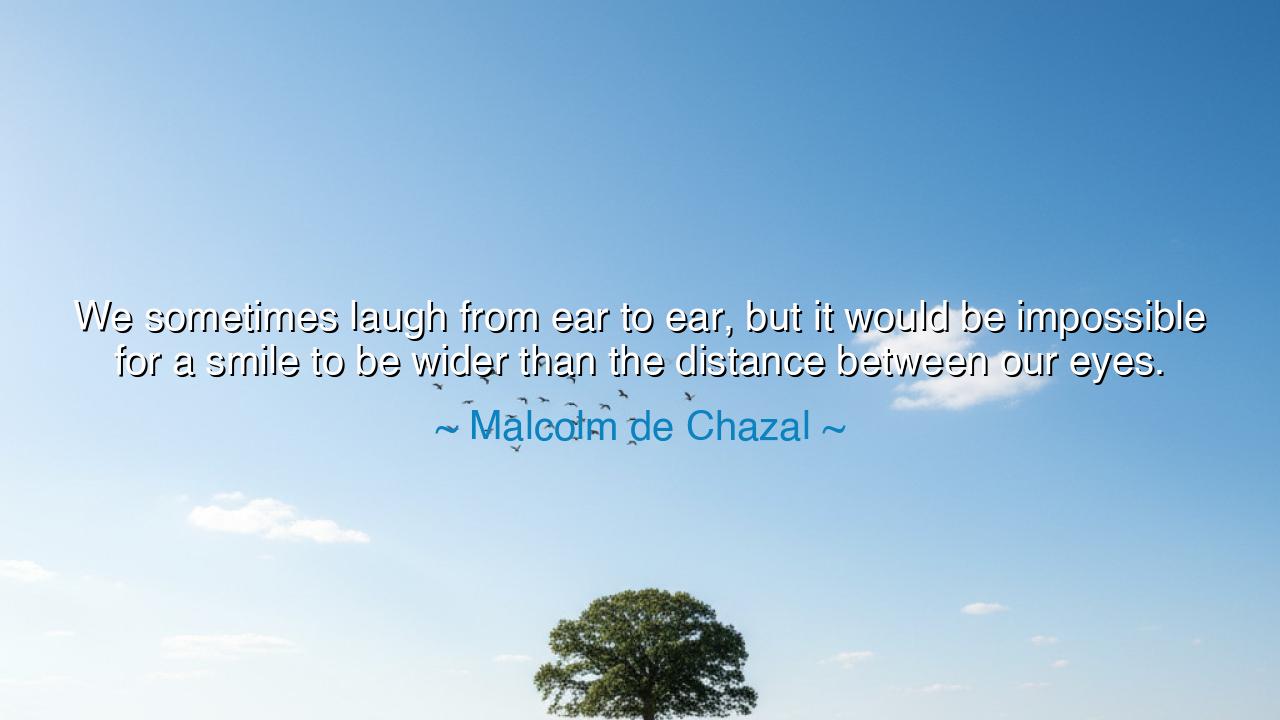
We sometimes laugh from ear to ear, but it would be impossible
We sometimes laugh from ear to ear, but it would be impossible for a smile to be wider than the distance between our eyes.






The words of Malcolm de Chazal, “We sometimes laugh from ear to ear, but it would be impossible for a smile to be wider than the distance between our eyes,” are woven with both poetry and wisdom. On the surface, it is a playful meditation on the limits of the human face. Yet beneath this lies a profound truth: that no matter how joyous, how expansive, or how radiant our smile, it is bound to the architecture of our being. The eyes form its boundary, its natural horizon. Thus, de Chazal reminds us that joy, though infinite in the heart, must always find expression within the frame of our humanity.
The ancients often spoke of the eyes as the dwelling place of truth. The mouth may smile, but if the eyes are cold, the smile becomes hollow. De Chazal’s observation hints at this same ancient wisdom: the width of a smile is not measured by the lips alone, but by the harmony between the lips and the eyes. True laughter, the kind that is said to stretch “from ear to ear,” is most beautiful when it ignites the light within the eyes, for then it is no mere gesture but a radiance of the soul.
Consider the story of Abraham Lincoln. His contemporaries often remarked on his face—plain, even homely—but when he laughed, his whole being seemed transformed. His smile, though narrow in physical space, shone with sincerity because his eyes bore the warmth of compassion and humanity. His joy, though carried within the limits of his features, filled entire rooms and eased the burdens of those who surrounded him. His life testifies that it is not the size of a smile that matters, but the truth that animates it.
De Chazal’s words also remind us of the paradox of human existence: we are bound by limits, yet within those limits lies infinite possibility. The distance between the eyes may be small, but within that frame the heart can pour oceans of joy. Just as the harp has only so many strings, yet within them infinite melodies may be born, so too the smile—though bounded—can express boundless love, kindness, and delight. The boundary does not diminish the beauty; it gives it shape.
There is also a warning in this teaching. Many seek to exaggerate their joy, to perform happiness for the sake of others, stretching their smiles wider than truth allows. But such smiles fail, for they betray themselves in the eyes. De Chazal’s reminder is that no smile can be wider than the soul permits. Authentic joy cannot be forced, nor can its boundaries be broken. The eyes—silent guardians of truth—will always reveal whether joy is real or counterfeit.
The lesson, then, is simple and eternal: do not seek to perform happiness, but to cultivate it genuinely. When laughter comes, let it rise from the heart and reach the eyes, for only then is it whole. A smile need not be vast to be powerful; it need only be true. The beauty of joy is not measured in breadth but in authenticity. And when joy is authentic, even the smallest smile can illuminate a world.
To live this wisdom, practice sincerity. When you feel joy, let it shine freely, even if it seems modest. When you feel sorrow, do not force a smile, for the eyes will reveal the truth. Instead, tend the inner garden of the heart—through kindness, gratitude, and honesty—so that when a smile blooms, it is natural, whole, and radiant. Let your eyes and smile walk in harmony, for together they speak the language of the soul.
So remember, O children of tomorrow: though we may laugh from ear to ear, our smiles are always bounded by the distance between our eyes. And yet within that sacred boundary lies infinite beauty, for the eyes and smile together hold the power to comfort, to inspire, and to reveal the deepest truths of the human spirit.






AAdministratorAdministrator
Welcome, honored guests. Please leave a comment, we will respond soon